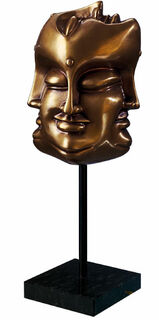Sculpture "Tête de Bouddha - Head of the Buddha", bronze
Sculpture "Tête de Bouddha - Head of the Buddha", bronze
Quick info
limited, 99 copies | numbered | signed | bronze + stone | patinated | polished | total size 20 x 53 x 20 cm (w/h/d)
Detailed description
Sculpture "Tête de Bouddha - Head of the Buddha", bronze
Edition in fine bronze. Cast using the Lost-Wax-Process by hand, patinated and polished by hand. Limited world edition of 99 copies, numbered and signed. On a diabase pedestal with a rod that can be turned freely in any direction. Size incl. pedestal 20 x 53 x 20 cm (w/h/d).
About Ma Tse Lin
Ma Tse Lin was born in Guan-dong, China, in 1960 as the son of a banker. His parents were devout Buddhists. At the age of 11, Ma Tse Lin's already revealed his remarkable artistic talent in painting Chinese letters at school. After graduating from the Beijing School of Art, he became the first Chinese student to be admitted to the École Nationale des Arts Décoratifs in Paris in 1985, where he won the first prize for painting.
Ma Tse Lin's first solo exhibition took place in Paris as early as 1988. Numerous other exhibitions followed in Europe, the USA and Asia. In the meantime, his works have found their way into renowned collections and museums in China and the United States. Today, the Chinese embassy proudly presents him as a figurehead of Chinese-European modernism.
After numerous experiments with a wide variety of materials, techniques and motifs, Ma Tse Lin now devotes his work exclusively to Buddha.
An alloy of copper with other metals (especially with tin) used since ancient times.
When casting bronze, the artist usually applies the lost-wax technique which is dating back more than 5000 years. It's the best, but also the most complex method of producing sculptures.
First, the artist forms a model of his sculpture. It is embedded in a liquid silicone rubber mass. Once the material has solidified, the model is cut out. The liquid wax is poured into the negative mould. After cooling down, the wax cast is removed from the mould, provided with sprues and dipped into ceramic mass. The ceramic mass is hardened in a kiln, whereby the wax flows out (lost mould).
Now we finally have the negative form, into which the 1400° C hot molten bronze is poured. After the bronze had cooled down, the ceramic shell is broken off and the sculpture is revealed.
Now the sprues are removed, the surfaces are polished, patinated and numbered by the artist himself or, to his specifications, by a specialist. Thus, each casting becomes an original work.
For lower-quality bronze castings, the sand casting method is often used which, however, does not achieve the results of a more complex lost-wax technique in terms of surface characteristics and quality.
Sculptural representation of person's head and shoulders.
A plastic work of sculptural art made of wood, stone, ivory, bronze or other metals.
While sculptures from wood, ivory or stone are made directly from the block of material, in bronze casting a working model is prepared at first. Usually, it is made of clay or other easily mouldable materials.
The prime time of sculpture after the Greek and Roman antiquity was the Renaissance. Impressionism gave a new impulse to the sculptural arts. Contemporary artists such as Jorg Immendorf, Andora, and Markus Lupertz also enriched sculptures with outstanding works.






